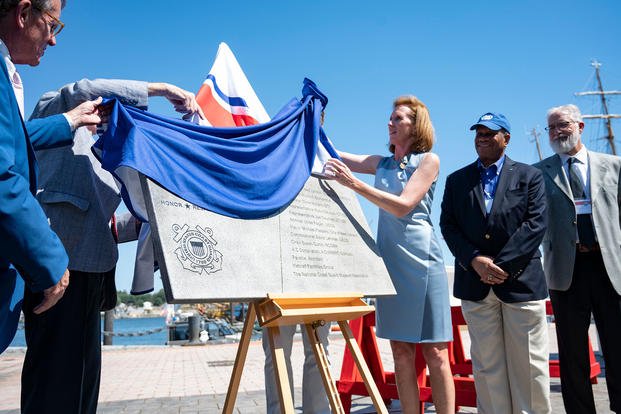
New London — Just before the U.S. Coast Guard Academy graduation ceremony began on an overcast and chilly morning last month, the hundreds of guests waiting on bleachers were entertained with photos and videos displayed on a giant screen facing Cadet Memorial Field.
One of those recordings was a slickly produced clip featuring a host of local, state and federal officials enthusing over the prospect of a new National Coast Guard Museum opening next year in downtown New London.
And appearances to the contrary, that timeline is correct, Wes Pulver, president of the museum association overseeing the $150 million project, said Tuesday as he walked the site of the future 89,000-square-foot, six-story building.
“We’ve had some delays, but I’m not stressed about it,” Pulver said walking past an excavator that minutes before was scraping mounds of stone from property between Union Station and the Thames River. “It’s our obligation to not cut corners.”
Steel in the ground
Pulver, a retired Coast Guard captain, said crews this week will begin laying down rebar steel ahead of adding concrete construction pads that will serve as the museum’s foundation.
“We’ll be done with that in June and then steel goes into the ground in July,” he said.
That anticipated framing, expected to last for several months, was delayed after prep work that began earlier this year found a host of underground issues that didn’t show up on easement maps and other survey documents.
Those issues included utility pipes, sewage lines and electrical components that needed shifting, and the decision to install underground “vaults” at various locations to allow for safer cable and pipe access. Pulver said project construction manager, the North Stonington-based AZ Corp, worked with city officials and representatives of Eversource, Amtrak, Cross Sound Ferry and other stakeholders to identify work-arounds.
“Adding the vaults, which we consider a long-term investment, will cost more, but doing most of the other work was just a matter of re-sequencing the order of the work that was going to happen anyway,” Pulver said. He said ensuring an on-site pedestrian walkway that doubles as an emergency vehicle road was also a priority.
The Coast Guard Museum Association’s Board of Directors a year ago approved allotting $40 million for the installation of concrete mats, consisting of rods drilled into the bedrock 10 feet deep, to provide the stability needed to support the building. A portion of City Pier was dismantled, and a bulkhead wall added to create land where there was once water, essentially ensuring the museum had enough property to rest on.
Construction bid events held last year attracted dozens of prospective contractors hoping to be awarded jobs related to the concrete foundation, skeletal steel and flooring, as well as the exterior metal panels, glass curtain wall and roofing. Bids were also awarded for elevators — pits are already dug for the conveyances, both freight and passenger — fireproofing, plumbing and electrical work.
The Coast Guard remains the only branch of the armed services without a national museum and several of the facility’s completed floors, or “decks,” each will be dedicated to a specific Coast Guard theme, including safety, security and stewardship.
A Sikorsky MH-60T Jayhawk, the helicopter used by the Coast Guard for search and rescue operations, will be displayed in the museum’s atrium, while a top-level deck will feature a memorial terrace, simulation center and event space. The Eagle, a training vessel for cadets at the Coast Guard Academy, is expected to be a main feature of the museum and will be docked at nearby City Pier when the ship is in New London.
Federal funding, donations and lenders
Those kinds of bells and whistles come with a steep price tag, but it’s one Pulver said his group is well on its way to covering.
The project’s estimated $150 million cost ― about 70% of which will go to construction costs ― will be paid for through a private/public partnership that includes $50 million in federal funding. Another $52 million — $2 million more than initially hoped for — was raised by private donors with about 6,500 people chipping in, said Patti Fazio, the association’s director of marketing and communications.
“In our Alexander Hamilton Circle of donors, which is $2.5 million and above, we have two: the J.D. Power Family and the Coast Guard Foundation,” Fazio said Thursday.
“But we need more,” Pulver said.
Pulver said the association has identified a “trusted lender” willing to close a funding gap that could range as high as $48 million.
“We’re going to continue fundraising and hope to raise between $10 million and $15 million more,” he said. “The more we raise, the less we’d need to borrow.”
Pulver said he’s looking to wait until the framing work begins before entering into a formal lending agreement. If money is borrowed, the association expects to enter a lease agreement with the Coast Guard instead of immediately gifting the museum to the branch as initially planned.
Revenue from the museum — and lease payments — would be used to pay off any loan before keys are formally handed over to the Coast Guard.
Another major portion of the work includes the construction of a pedestrian bridge planned to run from the third level of the five-story Water Street parking garage, crossing over Water Street to allow access to the ferry terminal, the museum and train platforms.
The state has pledged $20 million for construction of the 400-foot pedestrian bridge, which is not part of the $150 million main museum project cost. Bridge construction bids are due June 30. The garage is also expected to undergo an expansion that will add 400 spaces to the 910-space structure’s upper three levels.
“For years, everyone’s been hearing the building will be built next year,” Pulver said. “I’m confident we’ll be turning a museum over to the Coast Guard next year, whether that’s through a lease or handing them the keys.”
The museum’s opening has been a hotly-anticipated goal for city officials, tourism boosters and local businesses hoping to capitalize on the hundreds of thousands of visitors — and their disposable income — predicted to pass through the building’s glass doors. As recently as the City Council’s June 2 meeting, the topic of the museum was raised as part of a larger downtown parking discussion.
Mayor Michael Passero, who frequently touts the museum as one piece of a larger downtown renaissance, said his administration is making a concerted push to fill vacant downtown buildings ahead of the facility’s grand opening — and the crowds of visitors expected to flock to the city.
“If anything, there’s now a feeling things are imminent, Passero said.
© 2025 The Day (New London, Conn.). Visit www.theday.com. Distributed by Tribune Content Agency, LLC.
© Copyright 2025 The Day, New London, Conn.. All rights reserved. This material may not be published, broadcast, rewritten or redistributed.




